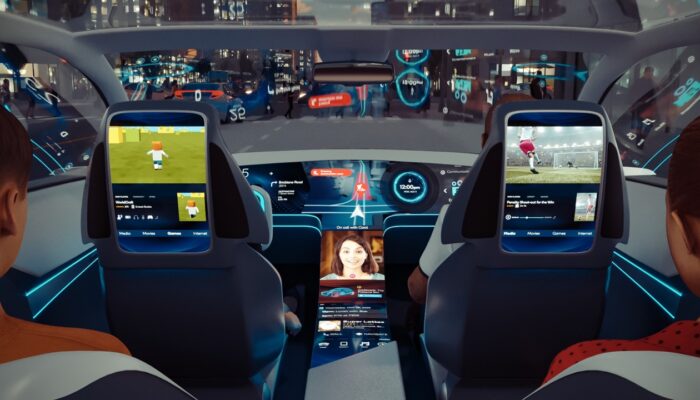I believe growth thrives at the crossroad of technology and humanity. This is where technology creates solutions that help people reach their greatest potential.
When it comes to innovation in transportation, we again see this intersection shaking up an industry on the verge of a technological leap: the next generation, connected software-defined car for an elevated human-centered experience.
A futurist viewpoint of the automobile’s role in our lives
“The next gen vehicle is a connected vehicle. Connectivity and 5G specifically is predicted to have a huge impact on the automotive industry overall with almost 20% of the projected global economic effect coming from the broader automotive sector translating into $2.4 trillion in economic output by 2025,” said Nakul Duggal, sr. vice president and general manager, automotive, for Qualcomm Technologies, in his keynote address for Automobil-Elektronik Kongress – Special 2020.
What is underway in transportation comes from a mindset shift on par with putting a thousand songs in your pocket afforded, of course, by the iPod. Where is this sea change coming from? We are at a pivotal moment when it comes to redefining the customer experience, the role of mobility in our lives, how we choose to spend driving time, and even lowering stress levels during daily commutes (one 2015 study found that driving is the most stressful of all commutes).
During the previous century, transportation was about moving people from one destination to another. Today, it’s about the driver and passenger experience, driven by technology – specifically the software inside the car – to create safer, more efficient and reliable modes of transportation.
Necessity is the mother of invention, as they say. The result: a software-defined car for a more human-centered experience.
Pivot technology: advanced driver-assistance systems (ADAS)
New technologies give way to new driver experiences, business models and strategic partnerships that are now reshaping the automotive industry. According to PricewaterhouseCoopers: “The automotive future is electrified, autonomous, shared, connected and yearly updated.” The Automobil-Elektronik Kongress mentioned earlier, for example, reveals how Qualcomm addresses the evolution of next-gen vehicles and, in collaboration with other partners, advances the transformation of the entire automotive industry. One technology, in particular, races to the top.
When it comes to the connected, software-defined car, we must look at the core technology driving (pun intended!) the new era of automotive travel: ADAS (advanced driver-assistance systems).
Simply put, ADAS is an electronic system that assists drivers with driving and parking functions.
There’s a broad set of stakeholders who influence ADAS: drivers, passengers, auto makers, pedestrians, cyclists, service providers, transportation networks, fleet operators, businesses, road owners, insurance companies, finance providers, cellular network operators, cities and government agencies.
The three most important components of ADAS are safety compliance, integrated software and integrated circuitry (think of this as the “hardware” of the vehicle). Like a classic jazz trio featuring piano, bass and drums, these three elements synchronize to become a scalable and upgradable solution with computing, connectivity and cloud service capabilities.
For instance, the Qualcomm® Snapdragon Ride™ Platform, designed to support the top three industry segments in automated driving, addresses the complexity of autonomous driving and ADAS. It leverages high-performance, power-efficient hardware, industry-leading artificial intelligence (AI) technologies and a unique autonomous driving stack to deliver a comprehensive, scalable and energy-efficient systems solution.
The role of 5G and connectivity is also key. Qualcomm is amplifying its expertise in 5G to fuel the automotive industry with products enabling OEM and auto makers to create best-in-class in-car experiences. Qualcomm’s Snapdragon Automotive 5G Platform offers advanced telematics systems that connect infotainment features with integrated multi-mode modems to support ultimate performance and provide multi-Gigabit low-latency speeds, lane-level navigation accuracy, and integrated cellular vehicle-to-everything (C-V2X) functionalities. The 5G capabilities allow for added safety and reliability on a platform designed with energy-efficiency in mind[CB1] .
The redefined human-centered automobile experience
Why now? In a post-COVID world, there will be more emphasis on the “in-car experience”. The next new normal makes the in-car experience become more relevant and critical. People can do all the things they could do sitting on an airplane while in a car. What can an auto manufacturer do to improve the experience?
Qualcomm, along with other industry partners like GM, BMW, and Jaguar Land Rover, are breathing life into a new story for the future of transportation.
Imagine:
- Preventing accidents by connecting to other vehicles and infrastructure on and off Wi-Fi networks.
- Organizing traffic flows more efficiently, so that carbon emissions can be reduced overall
- Coping with incidents in cities to keep traffic flowing, and prevent gridlock
- Helping people find places and parking more easily, reducing stress for drivers, helping reduce emissions and increase city efficiency
- Improving the experience for car users by providing better information to drivers and passengers
- Improving road planning and operations by providing better and more real-time information about road use to road authorities
- See it for yourself
In 1900, railroad engineer John Elfreth Watkins Jr. wrote an article for The Ladies Home Journal in which he predicted that the automobile would have widespread impact and put the “horse in harness” out of work. Ford ramped up his assembly line in 1908 so Watkins’s article had to have shaken readers to the core and created scores of naysayers.
Today, we sit on the threshold of yet another almost fairytale-like prediction: the connected, software-defined car as a personal assistant, safety manager, partner in snap judgements, stress reducer and efficiency expert. What does the future hold for transportation?
Qualcomm and its industry partners will address the future of transportation at Qualcomm’s Automotive Redefined: Technology Showcase, an exclusive two-day, virtual event to be held on January 26-27. Stay tuned for updates and announcements from Qualcomm on January 26.
#sponsored

